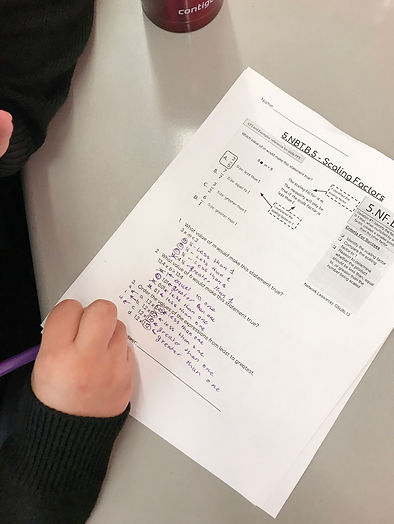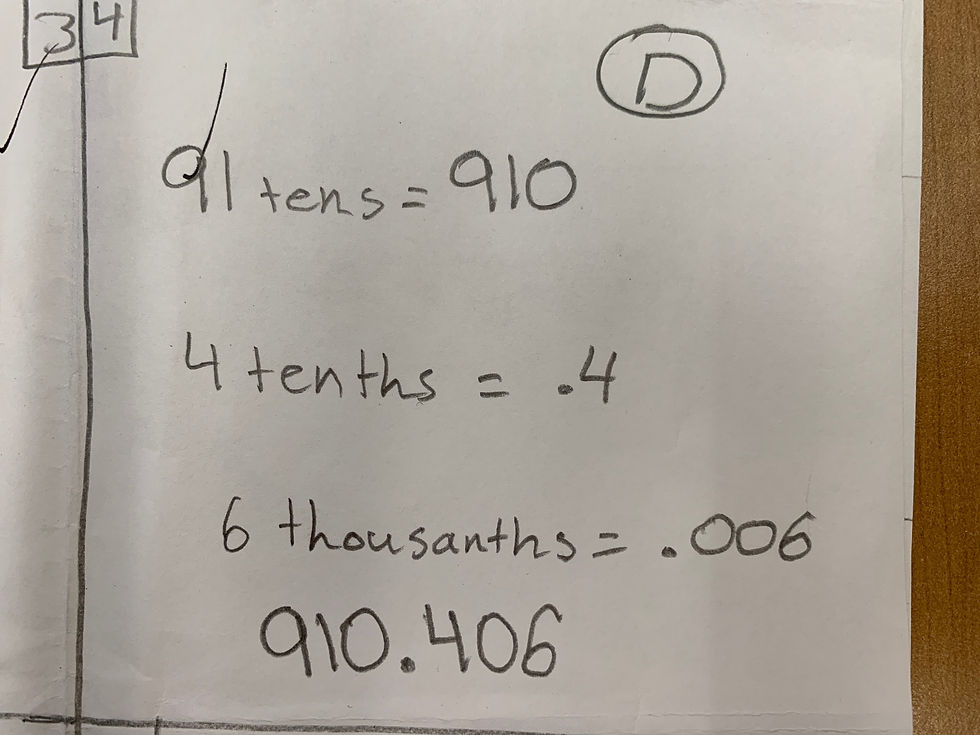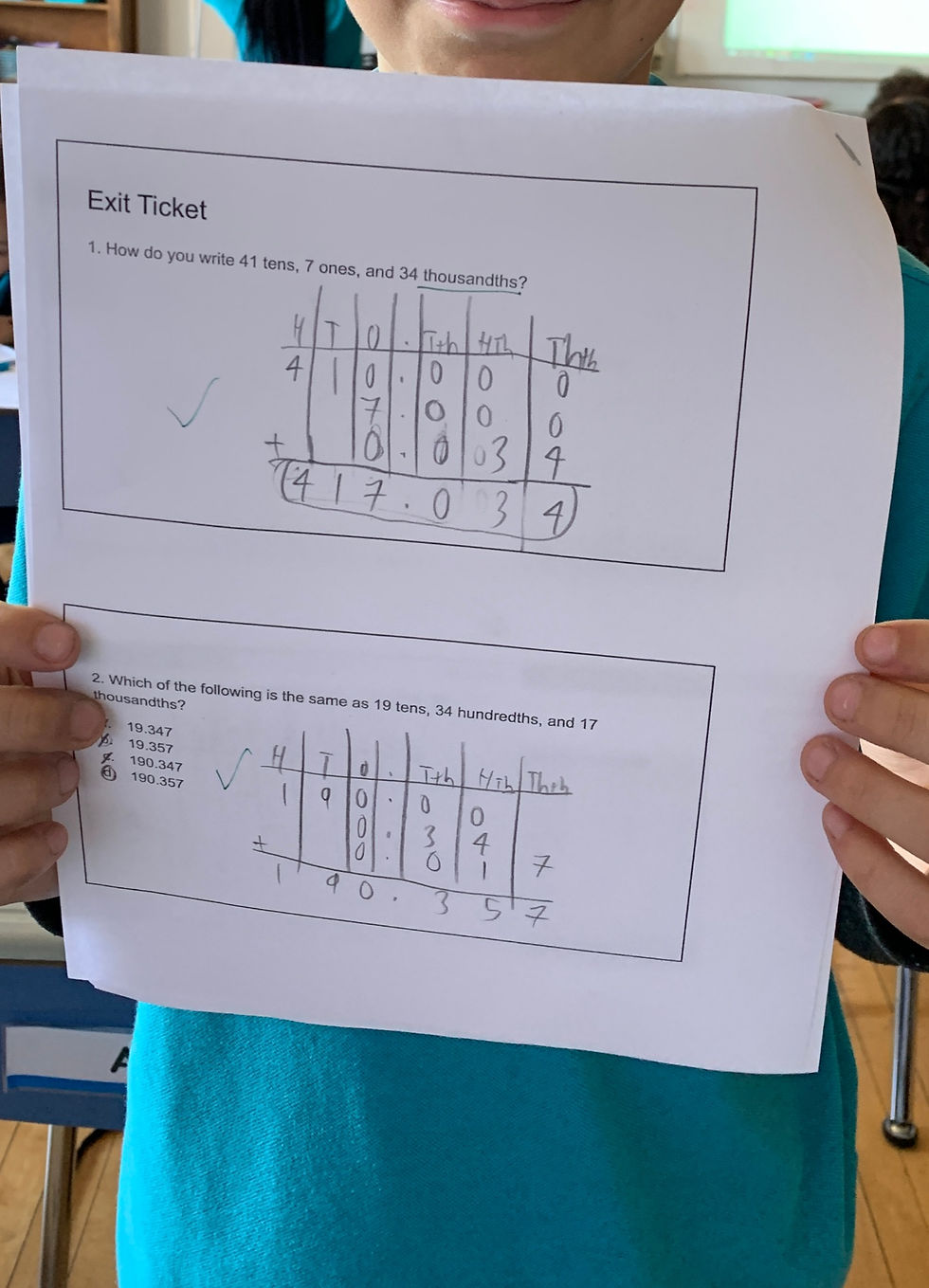Striving for Accuracy
Introduction
After observing my students during the first six weeks of school, it was apparent the habit of striving for accuracy would make a significant impact on their academic growth. During the first few weeks of school students take weekly quizzes to identify potential losses from the summer slide or misconceptions in early conceptions. This is particularly important in 5th-grade mathematics given the amount of conceptual understanding that is grounded in place value mastery throughout the year. While analyzing my students work, I noticed that they repeatedly scored less than 20% mastery on select all questions on topics which they demonstrated mastery on when given a more direct question. For this reason, I choose to explicitly teach and reinforcement the habit of striving for accuracy.
Explicit Instruction
To introduce students to Striving for Accuracy I choose to use a reteach lesson with the instructional strategy of charting the error. For this activity, students started the lesson by comparing and contrasting two pieces of student work from the previous week's quiz. Students were able to identify the misconception independently. Once this was completed, I led a class discussion that allowed students to rationalize the mistake in order to create a key taken away. Once students were able to identify their own area of growth in striving for accuracy, we created a criteria for success for students to reinforce this habit. Within the criteria for success, students were able to name good test-taking strategies to prove each answer choice correct or incorrect. This idea of "proving" their work became a buzzword in student discussion.

The image to the left is evidence of student's engaging in the lesson for striving for accuracy. This student demonstrates her understanding by identifying the scaling factor in each answer choice and annotating whether it is greater than, less than, or equal to 1. This allows her to "prove" each answer choice. The attention to detail for each answer choice is developing her habit of striving for accuracy.
Reinforcement Activities
After explicitly teaching my students about the Habit of Mind of Striving for Accuracy, I established three different reinforcement activities to continue my students' habit development. Each of these activities became routine in my classroom. On Mondays, students compared and contrasted student from last week's quiz. On Wednesdays, students completed a timed exit ticket in which some students focused on speed while others focused on accuracy. As weeks passed students came to realize that those who took their time had greater accuracy than those who completed the most problems. Every day after independent practice, students engaged in a peer feedback activity. Immediately implementing this activity built strong class engagement. Students became excited to work together on developing this habit and seeing the effects it had on their performance each day. Students became analytical of their own work by developing their skills of striving for accuracy together as a class. The impact has been an increase in student's mathematical accuracy and efficiency.
Neat vs. Mess
Below is one reinforcement activity I implemented to further students habit of striving for accuracy. For this activity, each Monday students looked at the three pieces of student work from last week's quiz. Students were initially asked which pieces of work were "neat" and which were "messy." From this, students were posed with the question: Why does this matter? After taking a second look at the pieces of student work, students were able to make the correlation between neat work and accuracy. This led us to a critical point that striving for accuracy would allow students to ensure they were selecting the correct and not making "silly mistakes." Given that this was relevant work they were evaluating, students were investing in improving before the upcoming weekly quiz.




Which matters more: speed or quality?
Below is another reinforcement activity I implemented to further students habit of striving for accuracy. For this activity, students completed an exit ticket. Each day when students complete an exit ticket, they are given 5 minutes to complete it. At this time of year, we are extra aware of how long students are taking to answer questions to gauge their exact time needed for state testing. Ultimately, students have unlimited time to complete their state test. Therefore while we prepare students for future standardized tests, this activity is essential to help students work efficiently.
Seen in the evidence below are two pieces of student work. In the first image, the student took his time to show his work and ensure he got the correct answer. In the second image, the student rushed through her work. It is apparent(from her erase marks) in the second image that she was checking her work, but her carelessness made it difficult for her to secure the correct answer. This activity highlighted the importance of taking pride in their work to "prove" each answer right or wrong.



Peer Feedback Survey
Below is the third reinforcement activity I implemented to further students habit of striving for accuracy. For this activity students completed 5 minutes of independent practice following our main lesson. After students grappled with some problems independently by using their notes and the criteria for success, they shared their work with a partner. Students were first instructed to switch papers and evaluate their partners work silently for 1 minute. Once the timer went off, students were instructed to give their partner feedback. Each partner had 1 minute to share their feedback. Immediately following students jumped into partner practice to try a problem together for 3 minutes. Seen below is students engaged in a peer feedback survey to give one another feedback on their quality of work.

The image to the left is evidence of student's engaging in peer feedback in order to increase their habit of striving for accuracy. This image demonstrates my goal of helping students see that the teacher is not the only resource to them in the room. In fact, they can grow significantly from working with one another.
The image to the right is evidence of students engaging in peer feedback. This image is different from the collaboration above because one student is giving feedback to another student who missed the lesson. This demonstrated how striving for accuracy was important regardless of the learning setting.

Conclusion
During the first months of the 2018-2019 academic year, I was able to get to know my students. It did not take long for me to see their high level of mathematical understanding and preparation for fifth-grade mathematics. While my students were prepared they lack the habits to demonstrate their abilities through test-taking. For this reason, it was obvious that striving for accuracy was a habit to focus development on. After explicitily teaching students what striving for accuracy was, my students rebranded the habit and created a "prove it" movement. To support my student's movement I created three reinforcement activities throughout the week. Students thrived off the competition that this habit brought and the success they were seeing on their weekly assessment. From this experience, students have been able to build their skills and understanding of why striving for accuracy is pertainent to success throughout life.